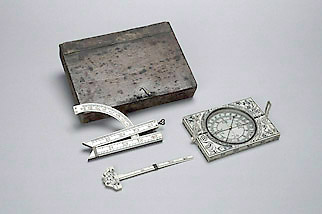
 |
| Catalogue |
 |
 Mining Instruments The compass is housed in a rectangular ivory box on a wooden core (106 ? 76 ? 11 mm). The compass bowl is 63 mm in diameter and has a circular scale 1 to 24, divided to 1 and 1/4, and numbered by 1. The same scale is also graduated with an inner ring of numbers 1 to 12, marked in red rather than black. The cardinal points are marked 'SE', ' OR', 'ME' and 'OC'. Around the compass is engraved flower and foliage decoration. One edge of the compass box carries a scale of equal parts [0] to [53], divided to 10, 5 and 1, and numbered by 10. At each end of the box, aligned with the meridian, is a folding ivory hook sprung to the vertical. These are used to suspend the compass from a line or chain. There is also a folding square of ivory on wood, with an ivory quadrant arc. The two legs carry a scale of equal parts [0] to [45], divided to 10, 5, 1 and 1/2, numbered by 10 in red. The unit is the same as appears on the compass box. These are in principle sectoral scales, though it is not clear that the instrument was used as a sector. The quadrant arc runs from [0] to 90 degrees, divided to 10, 5 and 1, and numbered by 10 in red. A screw in the end of one of the legs allows that leg to be clamped in any position as it moves over the arc. The final surviving instrument is a small ivory T-square with engraved bird decoration on the head. The stock carries another similar scale of equal parts [0] to [45], divided to 10, 5, 1 and 1/2, and numbered by 10 in red. There is a brass cursor which slides along the scale. From the shape of the storage compartment, at least two instruments are missing from the set, one of them a hanging clinometer. Formerly in the Michel Collection and the Billmeir Collection (accession no. 57-84/136). Stephen Johnston |



